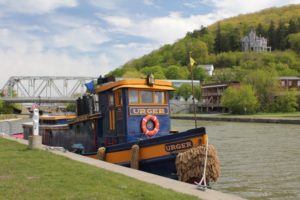Andebit et beaqui corendit, ut quostes esciendion re dit ad et prae parion es quia quas alibus sam, omnim faciden ducipidiat arum autem nobis enis es voat

16. Whitehall: A Naval Birthplace
Benedict Arnold and the Rebels take advantage of the prosperous community of Skenesborough.

Whitehall is known locally as the “Birthplace of the U.S. Navy.” It is one of several places that holds claim to such a title. The U.S. Navy traces its lineage to Philadelphia, the seat of the second Continental Congress, where a resolution was passed on October 13, 1775, creating the origins of the Continental Navy. Other claims include Machias, Maine; Providence, Rhode Island; and Marblehead, Massachusetts—but none of these predate the naval action that took place beginning on Lake Champlain in May 1775.
Nevertheless, the U.S. Navy does not recognize Whitehall’s claim, noting these operations were under the authority of the Continental Army. None of this dissuades the people of Whitehall from defending their title as the birthplace of the U.S. Navy.
On May 11, 1775, Benedict Arnold and Ethan Allen raided Skenesborough with the aim of commandeering some of Colonel Philip Skene’s ships. Skene was away in London when the Rebels seized Skenesborough. As Skene was a Loyalist, many of the locals were not too fond of him—so they looked the other way when Arnold and his Rebels helped themselves to a few of Skene’s goods. During the raid, Arnold and Allen captured Skene’s two-masted ship, Katherine. With little effort, they then captured the British-held forts Ticonderoga and Crown Point. Arnold renamed Skene’s ship USS Liberty and embarked on an assault on the British shipyard at St. John, Quebec.
On May 16, the ship was stalled due to lack of wind north of Isle la Motte, so Arnold and 35 men led the assault in small boats. After rowing all night, they attacked the fort at St. John, capturing the sloop George and renaming it Enterprise. The two warships gave the Rebels control of Lake Champlain.
It was natural that Arnold would take advantage of Skene’s community to expand the Rebel fleet. Skene had erected a forge, built and ran several sawmills, constructed roads, and built ships. Several additional ships were constructed for the transport of troops during Montgomery’s and Arnold’s 1775-76 Invasion of Canada. Arnold returned here in 1776 to construct several additional ships that would take part in the 1776 Battle of Valcour. The USS Liberty survived all the action at Valcour and was one of the ships that the Rebels used to escape Fort Ticonderoga in July 1777.
When the Rebels retreated from Fort Ticonderoga, they disembarked at a portage road below Skenesborough Falls, where bateaux (oversized rowboats) were prepared to take the Rebels along Wood Creek, where they would travel on to Fort Anne.
Some troops stayed in Skenesborough to unload the mountain of supplies carried out of Fort Ticonderoga. About noon, the first of Burgoyne’s ships, sailing single-file down the narrow waterway, encountered the retreating Rebels. Anticipating Burgoyne’s imminent arrival, the troops set fire to much of Skene’s settlement, including the mills, storehouses, and the remaining bateaux. The Rebels then quickly retreated to guard the rear of the retreating troops.
The Rebels had destroyed Skene’s settlement. Of the hundreds that escaped Fort Ticonderoga, Burgoyne had taken 30 prisoners. Burgoyne dispatched the 9th Regiment of Foot to catch the fleeing Rebels while he settled into the home of Philip Skene, the only building that remained after the fire.
Travel Tools
Start track 16 as you enter Whitehall and cross over South Bay.
Don’t miss the 16-foot diorama with light and sound show at the Skenesborough Museum that describes the settlement of Skenesborough and the events that led to the building of 13 ships in Skenesborough harbor in 1776. For more information: www.lakestolocks.org/content/skenesborough-museum-and-heritage-area-visitor-center/ltla2917d1799e43603b
The heart of Whitehall, at the intersection of Lake Champlain and the Champlain Canal, is picturesque and worth a stroll along the canal. For more about the town, visit www.lakestolocks.org/content/whitehall/ltl2a41df0e101fdcee0
Local Bites
Historic Grounds. Serving homemade baked goods, breakfast, and sandwiches in a beautiful historic building. Don’t miss the Sunday brunch. 142 Main St, Whitehall.
CLICK TO ADVANCE PAGE TO SITE SEVENTEEN
First-Hand Accounts
The Rebels’ scorched earth policy—aka destroy everything left behind—when fleeing Fort Ticonderoga:
“The Brigade and Gun boats immediately attacked the rebels, with so much spirit that two of them very soon struck. The other three were blown up, and the enemy having previously prepared combustible materials, set fire to the Fort, mills, storehouses bateaux &c. and retired with the detachment left for that purpose …. a great quantity of provisions and some arms were here consumed, and most part of their officer’s baggage was burned, sunk or taken. Their loss in the attack is not known, about thirty prisoners were made, among which were two wounded officers.” –General John Burgoyne
The Rebels left the same destruction in their wake, when going through Skenesborough:
“The enemy had caused great devastation here and except for one stone house, in which Liet. Gen. Burgoyne was lodging, all the houses had been burned down. This was done out of hatred for Colonel Skene, who owned this region and who was with our army. All sorts of mills had been burned for this same reason.” –Julius Wasmus


